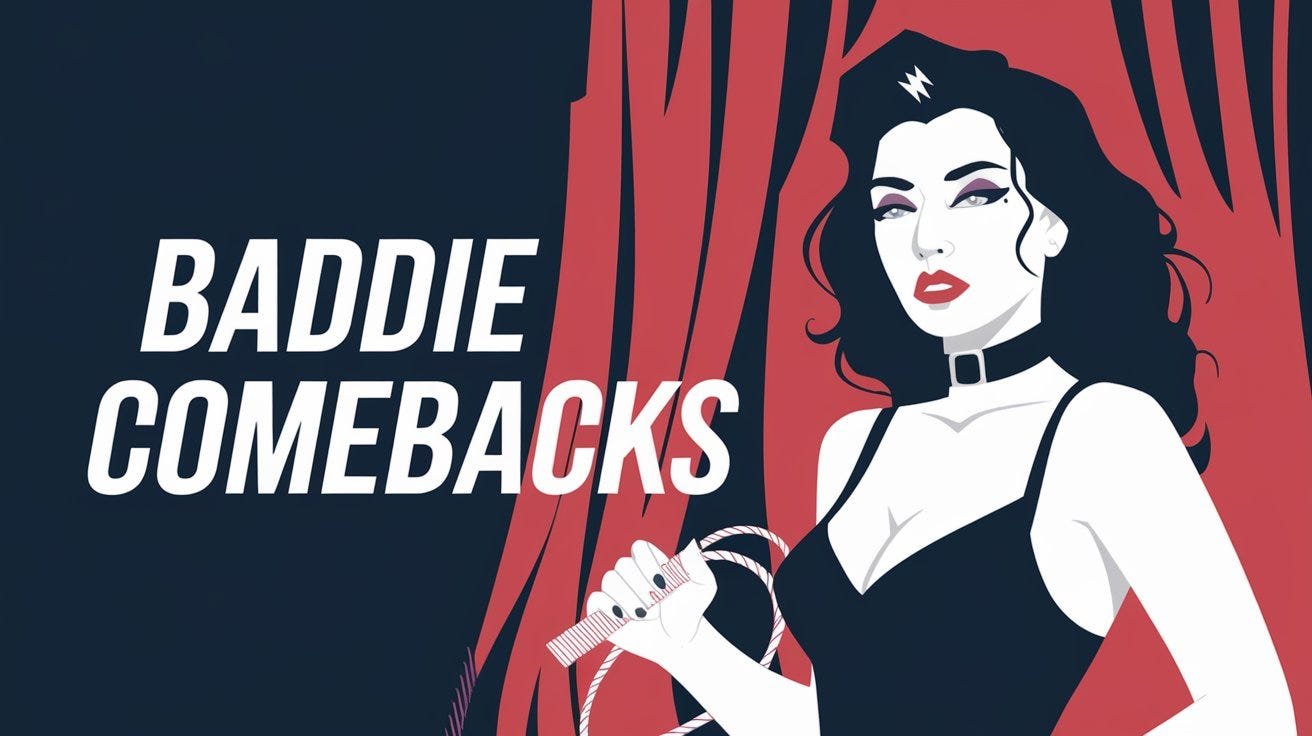Mastering the Art of Baddie Comebacks: A Complete Guide to Confident Responses
In today’s social landscape, the ability to deliver powerful, self-assured responses has become increasingly important. This comprehensive guide explores the world of “baddie comebacks” – clever, confident replies that assert your presence while maintaining composure and class. Whether you’re dealing with criticism, unwanted comments, or simply want to enhance your communication skills, this guide will help you navigate social interactions with grace and authority.
Understanding the Baddie Mindset
What Makes a True Baddie Response
A baddie comeback isn’t just about being witty or sharp-tongued. It’s about maintaining composure while delivering responses that reflect self-assurance and emotional intelligence. The key elements include:
- Maintaining dignity and poise
- Speaking with conviction
- Staying true to personal values
- Demonstrating emotional maturity
- Commanding respect without seeking validation
The Psychology Behind Powerful Comebacks
Understanding the psychological aspects of effective responses can help you deliver them more naturally. Strong comebacks often stem from:
- High self-esteem and self-awareness
- Emotional regulation
- Quick thinking and adaptability
- Strong boundary setting
- Clear communication skills
Essential Components of Baddie Comebacks
Timing and Delivery
The effectiveness of a comeback often lies in its timing and how it’s delivered. Consider these aspects:
- Pause briefly before responding
- Maintain steady eye contact
- Use appropriate tone modulation
- Keep facial expressions controlled
- Employ strategic body language
Language Choice and Tone
Your word choice and tone can make or break a comeback. Focus on:
- Using clear, precise language
- Avoiding excessive emotional charges
- Incorporating subtle humor when appropriate
- Maintaining professional demeanor
- Choosing words that reflect confidence
Situations and Appropriate Responses
Handling Workplace Comments
Professional environments require particularly tactful responses. Here are some examples:
- For unsolicited advice:
“I appreciate your perspective, but I’m confident in my approach.” - For credit-stealing:
“Yes, as I mentioned when I introduced that idea last week…” - For undermining comments:
“Let’s focus on the results, which speak for themselves.”
Social Media Interactions
Digital platforms require special consideration for comebacks:
- For negative comments:
“Thank you for taking time to share your thoughts. I’ll give them the consideration they deserve.” - For trolling:
“Your energy would be better spent on self-improvement.” - For unsolicited opinions:
“Not everyone has to understand my choices to make them valid.”
Advanced Baddie Comeback Techniques
The Art of Subtle Shade
Sometimes the most effective comebacks are those delivered with subtlety:
- Use elegant word play
- Incorporate double meanings
- Employ strategic pauses
- Master the art of implications
- Perfect the polite dismissal
Power Moves and Body Language
Physical presence plays a crucial role in delivering effective comebacks:
- Stand or sit with proper posture
- Use hand gestures purposefully
- Maintain composed facial expressions
- Control your breathing
- Own your personal space
Developing Your Personal Style
Finding Your Voice
Every individual should develop their unique approach to comebacks:
- Identify your natural communication style
- Build on your personal strengths
- Practice authentic responses
- Develop signature phrases
- Create a personal brand of wit
Cultural Awareness and Adaptation
Understanding cultural contexts helps in delivering appropriate comebacks:
- Consider cultural sensitivities
- Adapt to different social settings
- Respect diverse perspectives
- Navigate international interactions
- Maintain cultural appropriateness
Common Mistakes to Avoid
Emotional Pitfalls
Being aware of potential emotional traps can help you maintain composure:
- Responding too quickly
- Letting anger drive responses
- Taking things too personally
- Seeking revenge
- Losing emotional control
Communication Errors
Avoid these common communication mistakes:
- Using excessive profanity
- Making personal attacks
- Being overly defensive
- Misreading situations
- Responding to everything
Building Confidence for Better Comebacks
Mental Preparation
Strong comebacks require mental readiness:
- Practice positive self-talk
- Visualize successful interactions
- Develop emotional resilience
- Build self-awareness
- Maintain personal boundaries
Practice Techniques
Improve your comeback skills through:
- Role-playing exercises
- Recording and analyzing responses
- Studying successful communicators
- Getting feedback from trusted friends
- Regular self-reflection
Digital Age Considerations
Online Presence Management
Managing your digital presence affects comeback effectiveness:
- Maintain professional online profiles
- Consider long-term implications
- Document important interactions
- Build a positive digital footprint
- Control your narrative
Social Media Strategy
Develop a strategy for online interactions:
- Choose your battles wisely
- Time your responses strategically
- Maintain brand consistency
- Use platform-appropriate language
- Keep receipts when necessary
Professional Growth Through Comebacks
Career Advancement
Strong comeback skills can benefit your career:
- Navigate office politics
- Handle difficult clients
- Lead team discussions
- Present ideas confidently
- Build professional relationships
Leadership Development
Use comeback skills to enhance leadership:
- Guide team interactions
- Resolve conflicts effectively
- Set professional boundaries
- Mentor others
- Build team confidence
Maintaining Long-term Success
Continuous Improvement
Keep developing your comeback skills:
- Stay current with communication trends
- Adapt to changing social norms
- Learn from each interaction
- Expand your repertoire
- Seek feedback and growth opportunities
Building a Support System
Create a network that supports your growth:
- Connect with mentors
- Join professional groups
- Share experiences with peers
- Seek constructive criticism
- Celebrate successes
Conclusion
Mastering baddie comebacks is an ongoing journey that requires dedication, practice, and self-awareness. By focusing on developing these skills while maintaining authenticity and respect, you can build a powerful communication style that serves you well in both personal and professional settings. Remember that the goal isn’t to tear others down but to stand firm in your worth and communicate with confidence and grace.
Remember to practice these techniques responsibly and always consider the context and potential impact of your responses. The true mark of a baddie isn’t just in having the perfect comeback, but in knowing when and how to use it effectively while maintaining your dignity and respecting others.
Additional Resources
Recommended Reading
- Books on communication skills
- Articles on emotional intelligence
- Studies on body language
- Guides on professional development
- Research on social psychology
Practice Tools
- Communication workshops
- Public speaking groups
- Online role-playing platforms
- Professional coaching services
- Networking events
Last Updated on December 27, 2024 by Shahid Maqsood
Shahid Maqsood, with an MBA and a Master’s in Mass Communications, has 10 years of writing experience. Specializing in news and celebrity coverage, he brings a unique perspective from his love for hunting and camping, difference between. He’s passionate about the outdoors, especially hunting and camping. Shahid contributes to websites like dosttrusty.com, distinctionbetweencom and bruitly.com offering insightful articles on news and celebrities. His straightforward, engaging style makes him a trusted source for readers.






